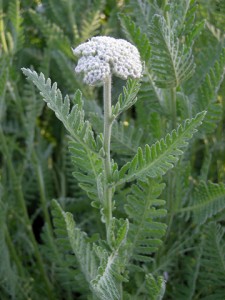Common yarrow’s Latin name, Achillea millefolium, was given in honour of Achilles, the Greek hero, who is said to have made an ointment from yarrow to heal the wounds of his soldiers during the siege of Troy 3,000+ years ago. Indeed, the plant’s healing properties are mythic. It is reported to be diaphoretic, diuretic, stimulant, astringent, and tonic. It apparently reduces hair loss, helps with toothaches, cures spider bits, increases milk supply, reduces fever, and, if you roll the leaves up and stick the wad up your nose, it’s supposed to stop nosebleeds.
The second part of its Latin name, millefolium, is descriptive. Yarrow leaves are long, lacy and much-divided. The plant has the appearance of having 1000 leaves.
The flowers are white clusters on top of long stems. They dry well and their golden heads can be seen standing through the snow throughout the winter.
To see yarrow in profusion, stroll Campers Link ski trail next to Sandy McNabb campground in August.
Photo by orchid galore – http://www.flickr.com/photos/25609635@N03/2670694691/


You must be logged in to leave a reply.